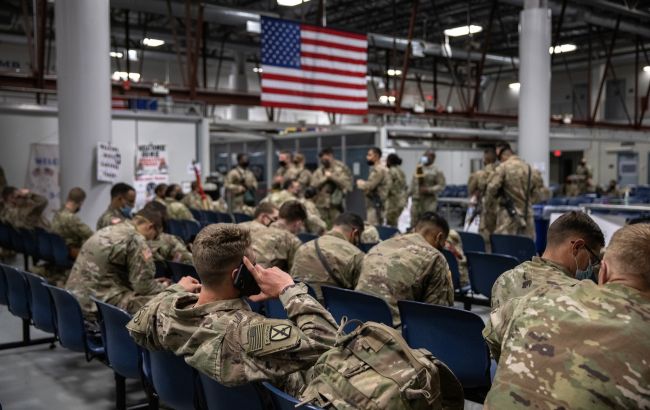Strike on U.S. military base in Jordan: Details and options to respond
 U.S. military (Illustrative photo: Getty Images)
U.S. military (Illustrative photo: Getty Images)
On January 28, an enemy drone attacked the U.S. military base Tower 22 in northeastern Jordan, near the Syrian border. Three military personnel were killed, and more than 40 were injured, marking the first deadly strike on the American military, stationed in the Middle East, since the Israel-Hamas hot war started, raising tensions within the region. Pentagon said the attack had the "footprints" of Iran-backed Iraqi militia Kataib Hezbollah.
RBC-Ukraine collects all the details of the incident known so far and suggests what are the options for the U.S. to respond.
Sources used: Pentagon statements, Reuters, AP News, BBC, CNN, Politico.
Tower 22 military base
The military base that came under attack, named Tower 22, is close to the demilitarized zone (DMZ) on the border between Jordan and Syria. The Iraqi border is just 10 kilometers (6 miles) from there. More American soldiers were deployed there when the U.S. entered Syria in late 2015. The little base has about 350 U.S. Army and Air Force people, including engineering, aviation, logistics, and security teams.

Tower 22 military base (Planet Labs PBC/BBC)
Details of the attack
The enemy UAV hit the housing unit where the American troops were staying. Later, U.S. officials said it was a "type of Shahed drone", a kind of drone that Iran has been delivering to Russia for one-way attacks.
An air defense system at Tower 22 was not working at the time of the attack as the drome arrived at the same time as a U.S. drone was supposed to return to the base. The soldiers at the base were still in their sleeping areas as it was early in the morning, "with little to no warning", according to the officials.
While 3 Americans were killed, over 40 people were injured in the attack, and that number might increase.
The Pentagon later revealed the names of killed soldiers. "The three soldiers killed are Sgt. William Jerome Rivers of Carrollton, Georgia; Spc. Kennedy Ladon Sanders of Waycross, Georgia; and Spc. Breonna Alexsondria Moffett of Savannah, Georgia. All three were assigned to the 718th Engineer Company, 926th Engineer Battalion, 926th Engineer Brigade, Fort Moore, Georgia," the statement says.
The loss of Sgt. William J. Rivers, Spc. Breonna A. Moffett and Spc. Kennedy L. Sanders has left an indelible mark on the Army Reserve. These Citizen Soldiers died in service to their country on January 28, 2024, in Jordan.
— Chief of the Army Reserve & Commanding General (@ChiefUSAR) January 29, 2024
Their sacrifice will not be forgotten. pic.twitter.com/86fzn79ZTS
Who is responsible for the strike
The Pentagon primarily suggests this is an Iran-backed militia and the strike has the footprints of Kataib Hezbollah.
Formed after the 2003 U.S.-led invasion of Iraq, Kataib Hezbollah is a powerful Iraqi armed group close to Iran. It is part of the Islamic Resistance in Iraq, a coalition of harsh Shi'ite groups responsible for over 150 attacks on U.S. forces after the beginning of Hamas's large-scale bombardment of Israel.
Kataib Hezbollah is known for deadly attacks in the 2000s, using snipers, rockets, mortars, and bombs. The U.S. labeled it a terrorist organization in 2009. Previously led by Abu Mahdi al-Muhandis, it lost its leader in a 2020 U.S. drone strike.
The group follows a Shi'ite ideology considering Iraq, Syria, and Lebanon borders as Western-made. It sees U.S. troops in Iraq as occupiers, desiring their complete withdrawal.
With no clear leadership structure, the group has thousands of fighters, drones, rockets, and missiles. Even though it is supposed to follow the orders of Iraq's Prime Minister, the group acts on its own and disobeys the government, especially when it comes to targeting U.S. forces. The U.S. itself has struck its positions multiple times.
How the U.S. could respond
U.S. President Joe Biden reacted to the incident, saying the U.S. "will hold all those responsible to account at a time and in a manner of our choosing". He asked for a moment of silence in the memory of the deceased and added “And we shall respond”. When asked if he had figured out how to respond to the attacks, Biden said "yes" but did not provide further details.
Now the U.S. has several options for how to react. Washington also blames Iran, while Tehran denies its involvement. "I do hold....them responsible in the sense that they're supplying the weapons," Biden said when asked about Iran's role.
One of the options includes attacks on bases and leaders linked to Iran in Iraq and Syria, as the country has already done before. The U.S. could use precise missile strikes on military bases and weapon depots, but this has not yet stopped the militias from targeting U.S. troops again and again.
Option two includes an attack on Iran directly and it is the most unlikely scenario. Both the U.S. and Iran do not seek a full-scale war, and such a conflict could lead Iran to try closing the economically important Strait of Hormuz, impacting global oil and gas flow.
"I don't think we need a wider war in the Middle East. That's not what I'm looking for," said Biden. John Kirby, the Strategic Communications Coordinator for the National Security Council, echoed this position. “We don’t seek a war with Iran. We’re not looking for a wider conflict in the Middle East,” he said.
There is always an option - to do nothing. Some within the U.S. believe that considering the tensions in the Middle East, it would be unwise for the U.S. to target Iranian interests now. Others argue that the current strategy of deterrence has failed and that not responding strongly to raising attacks on U.S. bases has inspired more attacks.

